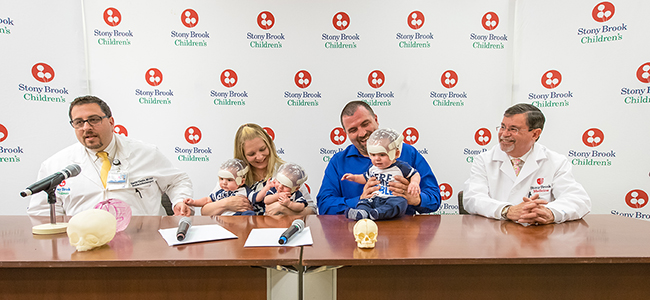
Assistant Professor of Neurological Surgery and Pediatrics at Stony Brook University
School of Medicine; parents Amy and Michael Howard; and Elliot Duboys, MD,
Associate Professor of Surgery at Stony Brook University School of Medicine.
Surgeons at Stony Brook Children’s Hospital have performed the first known surgery of its kind in the world on Long Island, NY, triplets whose skulls fused prematurely.
First-time parents Michael and Amy Howard of Center Moriches found out shortly after the birth of their triplets, Hunter, Jackson and Kaden, on Oct. 22, 2016, that all three baby boys were born with a skull condition known as craniosynostosis — a congenital premature fusion of one or more sutures (joints) on a baby’s skull.
The triplets, who were born at Stony Brook Children’s Hospital, were seen soon after birth by David A. Chesler, MD, PhD, Assistant Professor of Neurological Surgery and Pediatrics at Stony Brook University School of Medicine. Dr. Chesler is an expert in craniosynostosis.
Jackson and Hunter, who are identical, had what is known as sagittal synostosis (a long and narrow-shaped skull), while Kaden, the fraternal triplet, had what is called metopic synostosis (more triangular in shape). After CT scans were performed on each of the triplets, Dr. Chesler determined that all three triplets were excellent candidates for minimally invasive endoscopic craniosynostosis.
This type of craniosynostosis surgery generally must be performed within two to three months of birth. So on Jan. 5-6, 2017, just shy of turning three months old, the Howard triplets each underwent an endoscopic surgery to treat their craniosynostosis.
“The skull is not one big bone — it is made up of several plates,” said Dr. Chesler. “There are sutures (joints) between those plates that allow the skull to have a normal shape and size."
"When one or more of these plates fuse prematurely, the growth of the skull is restricted, resulting in an abnormal head shape and increased pressure exerted on the brain," he said. "If it is not surgically treated, there is a risk of injury to the brain and vision.”
While craniosynostosis itself is not all that uncommon — there is approximately one case in every 2,500 live births — the odds of triplets having the condition is extremely rare. In fact, the probability of seeing this occur in triplets again is one in 160 trillion.
With endoscopic craniosynostosis surgery, blood transfusions and incisions are minimal compared to open surgery, where blood transfusions are the norm and the incision can be six inches or longer. Endoscopic craniosynostosis operations typically take between 80 and 180 minutes, which was the case for each of the Howard triplets. And the average hospital stay is just one night. By Jan. 7, Kaden, Hunter and Jackson were ready to go home with their parents.
During the operation, Dr. Chesler with the assistance of Elliot Duboys, MD, Associate Professor of Surgery at Stony Brook University School of Medicine, made very small, one-and-a-half to two-inch incisions (compared to approximately six inch or longer incisions, had it been an open surgery) to endoscopically remove strips of bone.
Key to the success of endoscopic craniosynostosis surgery, is the use of a specially designed helmet post-operatively, to help mold the skull into a “normal” shape and aid in keeping the areas of removed skull from closing too quickly. Without the use of a helmet, the sutures would refuse in a relatively short period of time and the skull would resume growing abnormally.
Fast forward to May 2017, and Kaden, Hunter and Jackson are now six months old and doing great, hitting all of their developmental milestones. They wear their helmets 23 hours a day/seven days a week, to continue to help guide and mold the shape of their skulls. They will wear their helmets for another three to six months and are expected to do exceedingly well.

